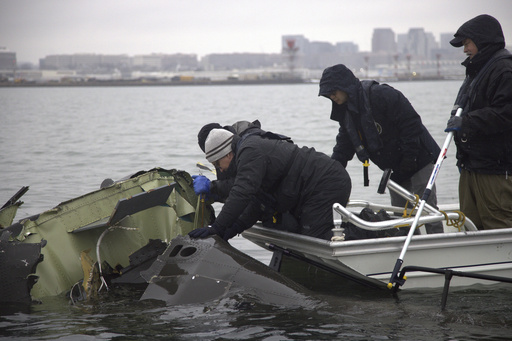
ARLINGTON, Va. — Recovery efforts commenced on Monday to clear wreckage from the Potomac River following a tragic midair collision that took place over Washington, D.C., resulting in the deaths of 67 individuals. This incident is marked as the worst air disaster in the United States since the year 2001.
Authorities reported that 55 out of the 67 deceased have been recovered and identified. John Donnelly, Chief of the Washington, D.C., Fire and EMS, expressed confidence that all victims will eventually be found. Crews were observed on a vessel equipped with a crane as they began their recovery operations.
Over 300 responders have been actively involved in the recovery mission, according to officials. Two Navy barges have been employed to assist in lifting the heavier parts of the wreckage.
Strict protocols are being followed by divers and salvage workers, with a directive to halt debris removal should any bodies be discovered, as stressed by Col. Francis B. Pera of the Army Corps of Engineers. The recovery of remains is being prioritized as a matter of utmost dignity.
The wreckage from both aircraft involved in the collision, which occurred near Ronald Reagan Washington National Airport, is set for removal. The American Airlines jet was carrying 64 passengers, while the Army Black Hawk helicopter had three personnel on board. Both aircraft collided Wednesday night, resulting in no survivors.
On Sunday, a group of family members were escorted by police buses to the banks of the Potomac River, close to the crash site.
Among the passengers on the American Airlines flight were figure skaters returning from the 2025 U.S. Figure Skating Championships in Wichita, alongside a party of hunters coming back from a guided trip. Those aboard the helicopter included Army Staff Sgt. Ryan Austin O’Hara, 28, Chief Warrant Officer 2 Andrew Loyd Eaves, 39, and Capt. Rebecca M. Lobach.
Federal investigators are currently working to unravel the sequence of events that resulted in the collision. Typically, such thorough investigations can span over a year; however, a preliminary report is expected to be available within the next 30 days.
This incident is noted as the deadliest in the U.S. since the tragedy on November 12, 2001, when a jet crashed into a New York City neighborhood shortly after takeoff, claiming the lives of all 260 passengers on board, in addition to five individuals on the ground.
While experts highlight the overall safety of air travel, the congested airspace surrounding Reagan Airport poses challenges for even veteran pilots.
The National Transportation Safety Board (NTSB) indicated that preliminary data revealed conflicting altitude readings between the airliner and the helicopter. Just before the impact, the jet’s flight recorder registered a change in pitch, although it is unclear if this was an attempt by the pilots to evade the crash.
At the time of the accident, data from the airliner’s flight recorder indicated an altitude of approximately 325 feet, with a margin of error of 25 feet. Conversely, control tower data recorded the helicopter at 200 feet, which is the permitted maximum altitude for helicopters in that region. The reasons for this discrepancy have not yet been clarified.
Investigators are aiming to reconcile these differences using data from the helicopter’s black box, while also planning to enhance the reliability of the tower data.

